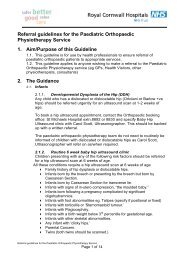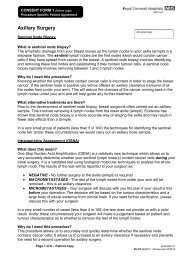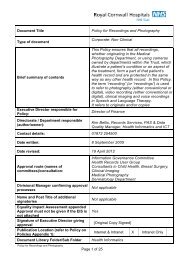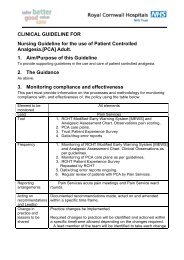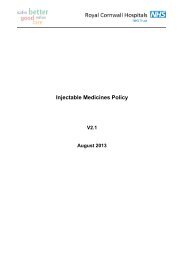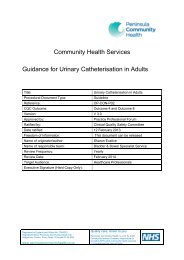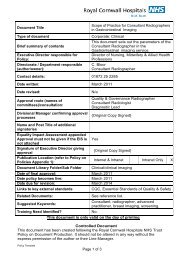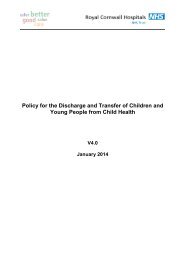Policy & Guidance for Risk Assessment & Risk Registers - the Royal ...
Policy & Guidance for Risk Assessment & Risk Registers - the Royal ...
Policy & Guidance for Risk Assessment & Risk Registers - the Royal ...
Create successful ePaper yourself
Turn your PDF publications into a flip-book with our unique Google optimized e-Paper software.
• Undertaking and participating in training as required• Implementing and adhering to <strong>the</strong> identified control measures to minimise <strong>the</strong>risks identified within <strong>the</strong> assessment• Raising concerns about any activity, practice or location that does not appear tohave a satisfactory risk assessment.• Seeking assistance with any aspect of <strong>the</strong> task when uncertain of <strong>the</strong> actions tobe taken.• Actively participating in training in relation to <strong>the</strong> application of this document.6. Standards and Practice6.1. <strong>Risk</strong> <strong>Assessment</strong>6.1.1. The risk assessments process is fundamental in ensuring both anenvironment that is safe <strong>for</strong> staff and patients and facilitating effective andproductive working practices.6.1.2. There are a number of specific risk assessment types that aredesigned <strong>for</strong> different activities; <strong>the</strong>se include, but are not restricted to,Generic Health and Safety risks, lifting and carrying risks, DSE/work station(computer), hazardous substances, plant & equipment, patient falls andwork at height assessments. Additional assessments are also required <strong>for</strong>certain groups of staff including new and expectant mo<strong>the</strong>rs, disabledpersons, young people and staff working during <strong>the</strong> night.6.1.3. The Trust’s specialist advisors will provide guidance oncompleting and <strong>the</strong> relevant types of risk assessments.6.1.4. <strong>Risk</strong> assessments will be carried out <strong>for</strong> all roles and activitiescarried out by or <strong>for</strong> <strong>the</strong> Trust. <strong>Risk</strong> assessments will be carried out bytrained staff from within <strong>the</strong> department and include consultation withrepresentatives of <strong>the</strong> area/activity. <strong>Risk</strong> assessments will be documentedusing <strong>the</strong> appropriate risk assessment template6.1.5. Once <strong>the</strong> risk assessment is completed it will be shared with allrelevant staff in <strong>the</strong> area and any additional controls required implementedwithin <strong>the</strong> given time frame. The risk assessment details will be added to<strong>the</strong> departmental risk register and, where appropriate, <strong>the</strong> directorate andTrust registers6.1.6. All risk assessments will be reviewed by <strong>the</strong> appropriate manageron an annual basis or more frequently if <strong>the</strong> circumstances change – i.e. achange in working practices, new equipment introduced, physical change inwork area or layout.6.1.7. <strong>Risk</strong> assessments will be reviewed within <strong>the</strong> Trust’s internal andexternal audit procedures including audits by <strong>the</strong> Health and Safety Team.6.1.8. <strong>Risk</strong> assessments should be held within <strong>the</strong> Datix system andused to compile <strong>the</strong> <strong>Risk</strong> <strong>Registers</strong>. Datix risk entries will be supplementedwith additional in<strong>for</strong>mation and evidence detailing <strong>the</strong> controls and actionstaken. Complex entries will also include breakdown of assessments using<strong>the</strong> Trust <strong>Risk</strong> <strong>Assessment</strong> Templates.<strong>Policy</strong> and <strong>Guidance</strong> <strong>for</strong> <strong>Risk</strong> <strong>Assessment</strong> and <strong>Risk</strong> <strong>Registers</strong>Page 5 of 21
6.2. <strong>Risk</strong> <strong>Assessment</strong> Process6.2.1. The risk assessment process <strong>for</strong> all types of risk will follow <strong>the</strong>same basic procedure, identification of <strong>the</strong> hazards, likelihood of risk, whois at risk, existing controls and review. A flow chart <strong>for</strong> <strong>the</strong> risk assessmentprocess is provided below. Generic guidance on completing <strong>the</strong> riskassessment process is provided in Appendix 1.6.3. <strong>Risk</strong> <strong>Assessment</strong> Process flow chartIdentify <strong>the</strong>HAZARDAnything (physical orprocess) with <strong>the</strong>POTENTIAL to causeHARM to persons orpropertyIdentify <strong>the</strong>RISKThe LIKELIHOOD of <strong>the</strong>harm from <strong>the</strong> HAZARDbeing realisedIdentify WHOMay beHARMEDStaffPatientsVisitorsContractorsProperty/Equipment, Etc.Identify <strong>the</strong>CONTROLSExisting andRequiredHow is <strong>the</strong> risk managedat <strong>the</strong> moment? –including: physicalcontrols, process andsystems of work, training,etc.Are additional controlsrequired?REVIEWEstablish a plannedreview period (usuallyannual) but prepare toundertake review of <strong>the</strong>assessment in <strong>the</strong> eventof any significant changein <strong>the</strong> activity i.e. changein personnel, equipment,software, incidents.<strong>Policy</strong> and <strong>Guidance</strong> <strong>for</strong> <strong>Risk</strong> <strong>Assessment</strong> and <strong>Risk</strong> <strong>Registers</strong>Page 6 of 21
6.4. Flowchart <strong>for</strong> escalation of <strong>Risk</strong>s<strong>Risk</strong> IdentifiedCan <strong>the</strong> risk beManaged Locally?YesNoEscalate tospecialty orDepartmentManagementReview & MonitorCan <strong>the</strong> risk bemanaged withinSpeciality/Department?YesReview &MonitorNoEscalate toDivisional LevelReview &MonitorYesCan <strong>the</strong> risk bemanaged within <strong>the</strong>Division?NoReturn toDivisional level<strong>for</strong> review of riskrating &managementNoYesLegendEscalate <strong>Risk</strong>Manage at levelReview &MonitorSubmit to <strong>Risk</strong>Committee <strong>for</strong>consideration toCorporate <strong>Risk</strong>RegisterReview &MonitorReturn toDivisional level<strong>for</strong> review of riskrating &managementMonitor & Reviewrisk regularlyDe-escalate andreview risk ratingYesAccept on Corporate<strong>Risk</strong> Register <strong>for</strong>review andconsideration by <strong>the</strong>Trust BoardNo<strong>Policy</strong> and <strong>Guidance</strong> <strong>for</strong> <strong>Risk</strong> <strong>Assessment</strong> and <strong>Risk</strong> <strong>Registers</strong>Page 7 of 21
6.5. <strong>Risk</strong> Register6.5.1. The Trust <strong>Risk</strong> <strong>Registers</strong> are <strong>for</strong>mulated from <strong>the</strong> entriescontained within <strong>the</strong> Trust’s electronic risk management system.6.5.2. <strong>Risk</strong> <strong>Registers</strong> will be complied from risk assessments undertaken<strong>for</strong> tasks, activities, roles and physical areas within <strong>the</strong> Trust’s areas ofresponsibility.6.5.3. Significant risks and risks with <strong>the</strong> potential to affect more thanone area or directorate will be will be considered by <strong>the</strong> risk Committee <strong>for</strong>addition to <strong>the</strong> Trust register.6.5.4. All proposed entries to <strong>the</strong> Corporate <strong>Risk</strong> Register will besubmitted from <strong>the</strong> <strong>Risk</strong> Committee to <strong>the</strong> Trust Board <strong>for</strong> final approvaland inclusion in <strong>the</strong> register.6.5.5. Divisional risk registers will, typically, record risks with a score inexcess of 12; all such risks will be reviewed quarterly by <strong>the</strong> Head of <strong>the</strong>Divisional6.5.6. Divisions of large size or with a complex structure may alsoestablish sub registers and committee(s) to monitor and review specialistrisks.6.5.7. <strong>Risk</strong> assessments will also be reviewed in <strong>the</strong> event of asignificant change in <strong>the</strong> working practices, procedures, systems andpersonnel. Fur<strong>the</strong>rmore, assessments will be reviewed and revised asappropriate in <strong>the</strong> event of a significant accident or incident or in <strong>the</strong> eventthat a trend or pattern of minor incidents is identified in a particular area.6.5.8. General risk assessments will be reviewed on a sample basis aspart of <strong>the</strong> periodic health and safety audits of divisions/areas/departmentsby <strong>the</strong> Trust Health and Safety Team.6.5.9. The Flowchart <strong>for</strong> escalation of <strong>Risk</strong>s is provided above6.6. Training6.6.1. General awareness of <strong>the</strong> process of risk assessment will be includedin within <strong>the</strong> existing Trust induction training. Staff who are nominated toundertake risk assessments within divisions and areas will receive training in<strong>the</strong> completion of risk assessments.6.6.2. Managers are responsible <strong>for</strong> ensuring that assessments arecompleted, are suitable and sufficient and <strong>for</strong> reviewing assessments willhave training incorporated into <strong>the</strong> manager’s health and safety training.6.6.3. Additional risk assessment training will be provided as required inaccordance with <strong>the</strong> Trust Core Training Needs <strong>Policy</strong>.<strong>Policy</strong> and <strong>Guidance</strong> <strong>for</strong> <strong>Risk</strong> <strong>Assessment</strong> and <strong>Risk</strong> <strong>Registers</strong>Page 8 of 21
6.6.4. The provision and arrangements <strong>for</strong> risk assessment training will bereviewed and revised as necessary.7. Dissemination and Implementation7.1. This document will be published on <strong>the</strong> RCHT Intranet site and available to allTrust staff. Where appropriate additional paper copies will be made available topersonnel without ready access to <strong>the</strong> intranet.7.2. Once <strong>the</strong> document is finally approved electronic copies will be held within <strong>the</strong>electronic Documents Library (DL2) and a link to <strong>the</strong> document provided within <strong>the</strong>“Daily bulletin” all user email.7.3. The final document will also be distributed to both <strong>the</strong> staff and managementrepresentatives of <strong>the</strong> Health and Safety Committee to ensure all divisions are awareof <strong>the</strong> requirements.7.4. The Trust arrangements <strong>for</strong> <strong>the</strong> risk assessment process, as defined in thisdocument, will be highlighted during Trust induction and mandatory training.7.5. The policy may also be provided to contractors and o<strong>the</strong>r third partiesundertaking work or activities <strong>for</strong> or on behalf of <strong>the</strong> Trust or on Trust premises.8. Monitoring compliance and effectivenessElement to bemonitoredThe undertaking, monitoring and reviewing of risk assessments andmanagement of risks within <strong>the</strong> day-to-day activities of <strong>the</strong> organisation.LeadThe Chair of <strong>the</strong> Trust <strong>Risk</strong> CommitteeToolReports created from <strong>the</strong> Datix <strong>Risk</strong> Management and reported to <strong>the</strong>monthly Divisional Governance meetings with higher level and organisationalrisks being reviewed by <strong>the</strong> <strong>Risk</strong> Committee.Significant health and safety risks may also be reported to <strong>the</strong> Trust Healthand Safety CommitteeFrequency Divisional Governance Committee Report Monthly <strong>Risk</strong> Committee - Monthly Health & Safety Committee – QuarterlyAs part of <strong>the</strong> scheduled health and safety audits a sample ofapproximately 10 <strong>Risk</strong> <strong>Assessment</strong>s from across <strong>the</strong> Trust will bereviewed each month.In addition a periodic review of <strong>the</strong> “Health and Safety Self Audit Tool”returns will be reviewed and trends identified at local, divisional and Trustwide levels; <strong>the</strong>se results will also feed into <strong>the</strong> PAF (from mid 2012)ReportingarrangementsDivisional Governance meetings will monitor <strong>the</strong> risk assessments <strong>for</strong> <strong>the</strong>division, including ensuring that local assessments are completed andreviewed.The <strong>Risk</strong> Committee will review all risks escalated to <strong>the</strong> Trust <strong>Risk</strong> Register(usually with a rating in excess of 15 but also lower level risks that may affectmore than one area/department. <strong>Risk</strong>s not accepted on <strong>the</strong> Trust <strong>Risk</strong>Register will be returned to <strong>the</strong> Division <strong>for</strong> review, fur<strong>the</strong>r evidence or localmanagement as appropriate. Trust <strong>Risk</strong> Register entries will be reviewed by<strong>the</strong> Trust Board at intervals not exceeding 12 calendar months<strong>Policy</strong> and <strong>Guidance</strong> <strong>for</strong> <strong>Risk</strong> <strong>Assessment</strong> and <strong>Risk</strong> <strong>Registers</strong>Page 9 of 21
Acting onrecommendations andLead(s)Change inpractice andlessons to besharedThe Health and Safety Committee will review all significant health and safetyrisks as reported through <strong>the</strong> biennial divisional reports.Divisional <strong>Risk</strong>s Are Reported To The Divisional Governance CommitteeAnd A Fur<strong>the</strong>r Report Requested.Health And Safety <strong>Risk</strong>s Will Be Discussed By <strong>the</strong> Health And SafetyCommittee and feedback to <strong>the</strong> division or department will be cascaded by<strong>the</strong> Divisional Safety Representatives and via <strong>the</strong> minutes of <strong>the</strong> meetings..Required changes to practice will be identified and actioned within <strong>the</strong> timeframe agreed at <strong>the</strong> appropriate committee depending on <strong>the</strong> level of riskidentified. A lead member of <strong>the</strong> relevant division, area or group will beidentified to take each change <strong>for</strong>ward where appropriate. Lessons will beshared with all <strong>the</strong> relevant stakeholders9. Updating and Review9.1. This document will be reviewed by <strong>the</strong> Trust Health and Safety Advisors withstaff consultation via <strong>the</strong> Health and Safety Committee prior to Trust approval andimplementation by <strong>the</strong> Governance Committee. The document will be subject to abiennial review cycle commencing in December 2012.9.2. In <strong>the</strong> event of a significant change in associated legislation or in <strong>the</strong> event of asignificant change in organisational structure or practices <strong>the</strong> document reviewmaybe brought <strong>for</strong>ward.9.3. Minor revisions, such as, amended job titles or changes in <strong>the</strong> organisationalstructure, approval can be sought from <strong>the</strong> Executive Director responsible <strong>for</strong>signatory approval, and can be re-published accordingly without having gone through<strong>the</strong> full consultation and ratification process.9.4. Any revision activity is to be recorded in <strong>the</strong> Version Control Table as part of <strong>the</strong>document control process.10. Equality and Diversity10.1. This document complies with <strong>the</strong> <strong>Royal</strong> Cornwall Hospitals NHS Trust serviceEquality and Diversity statement.10.2. Equality Impact <strong>Assessment</strong>The Initial Equality Impact <strong>Assessment</strong> Screening Form is at Appendix 2.<strong>Policy</strong> and <strong>Guidance</strong> <strong>for</strong> <strong>Risk</strong> <strong>Assessment</strong> and <strong>Risk</strong> <strong>Registers</strong>Page 10 of 21
Appendix 1. Generic <strong>Risk</strong> <strong>Assessment</strong> <strong>Guidance</strong>1. The requirement to undertake suitable and sufficient assessments of <strong>the</strong> risks arisingfrom work activities to <strong>the</strong> health and safety of employees and of those not employed,stems from regulation 3 of The Management of Health and Safety at Work Regulations1999 as amended.2. Some situations require specific risk assessments to be carried out includingactivities involving manual handling tasks, New and expectant mo<strong>the</strong>rs, young people andnight working.3. The Health and Safety Executive have identified 5 steps to carry out a riskassessment: -1. Identify <strong>the</strong> hazard2. Identify <strong>the</strong> risk3. Identify who is at risk4. Controls in place5. Additional controls required4. In order to identify a hazard it is necessary to define a few terms:• A HAZARD is any thing or situation that has <strong>the</strong> potential to cause harm,damage or injury.• The RISK is how likely <strong>the</strong> harm from <strong>the</strong> hazard is likely to occur• WHO is at risk – consider <strong>the</strong> groups of people who maybe affected includingstaff, visitors, contractors and patients – consider <strong>the</strong> types of patients and anyadditional factors that may change <strong>the</strong> risk level (i.e. elderly, immunesuppressed, children, visually impaired, etc)• The CONTROL MEASURES are <strong>the</strong> steps taken to prevent <strong>the</strong> harm occurring• LIKELIHOOD – how likely is <strong>the</strong> incident to occur – this is based on history ofincidents both locally and generally associated with this activity/equipment, etc.• SEVERITY – what would be <strong>the</strong> extent of <strong>the</strong> injuries or damage caused by <strong>the</strong>hazard. Consider Injuries, damage, PR, etc5. For example:• The main entrance to an reception is freshly cleaned floor and left wet =HAZARD.• RISKo If <strong>the</strong> floor is cleaned at 4 a.m. when <strong>the</strong> building is closed <strong>the</strong> RISK is verylow; = Lowo RISK. However, if <strong>the</strong> wet floor is cleaned at 8.30 in <strong>the</strong> morning, with all <strong>the</strong>staff and patients coming in <strong>the</strong> RISK will be High.• Severity of <strong>the</strong> injury or outcome of <strong>the</strong> risk will depend upon a number offactors including:The type of person (a minor fall may have very different outcome <strong>for</strong> a 25year old and an 85 year old!).The area where <strong>the</strong> incident occursThe time of day, lighting and wea<strong>the</strong>r conditions<strong>Policy</strong> and <strong>Guidance</strong> <strong>for</strong> <strong>Risk</strong> <strong>Assessment</strong> and <strong>Risk</strong> <strong>Registers</strong>Page 11 of 21
6. Although a large employer involved in wide ranging work activities, <strong>the</strong> majority of <strong>the</strong>Trust’s work is low or medium risk. To assess <strong>the</strong> possible impact of its activities <strong>the</strong> Trustuses a <strong>for</strong>m of semi-quantitative risk assessment. That is to say, it is a largely descriptiveprocess undertaken by individuals familiar with or involved in <strong>the</strong> activities beingconsidered, toge<strong>the</strong>r with use of a simple risk matrix to provide a numerical value andindicates whe<strong>the</strong>r it is high, medium or low risk.7. The risk matrix uses five possible levels of severity <strong>for</strong> an outcome and five <strong>for</strong> <strong>the</strong>likelihood of it happening. When <strong>the</strong>se are multiplied toge<strong>the</strong>r <strong>the</strong>y give a numerical value<strong>for</strong> <strong>the</strong> risk Value (see table 1). The overall process follows <strong>the</strong> Health and SafetyExecutive’s 5 Step Process and is explained step by step in <strong>the</strong> following paragraphs. TheTrust’s work<strong>for</strong>ce is divided up into groups with common job descriptions and roles. Assuch <strong>the</strong> most convenient way to conduct <strong>the</strong> process is to undertake assessments basedon <strong>the</strong> job description or role. If any employees are young and /or relatively inexperienced,women of child bearing age or disabled you must allow <strong>for</strong> any effect that this may have in<strong>the</strong> assessment.8. Managers are expected to undertake or arrange <strong>for</strong> (by someone who has beentrained) <strong>the</strong> assessment of risks within <strong>the</strong>ir work area. Employees must always beconsulted, ei<strong>the</strong>r directly or through <strong>the</strong>ir elected representatives. <strong>Assessment</strong>s must bereview whenever <strong>the</strong>re is a change to <strong>the</strong> work or <strong>the</strong> way it is undertaken or in <strong>the</strong>absence of change, at least annually.9. The outcome of <strong>the</strong> assessment should be recorded within <strong>the</strong> Datix system, <strong>the</strong> riskassessment:9.1 The easiest way to begin is to list <strong>the</strong> work activities of <strong>the</strong> employeesconcerned and <strong>the</strong>n ask “how could <strong>the</strong>y become injured doing this?” This shouldidentify <strong>the</strong> hazards – something that has <strong>the</strong> potential to cause harm. Now identify<strong>the</strong> controls you have in place to reduce <strong>the</strong> likelihood that <strong>the</strong> hazard will causeharm.9.2 Next estimate <strong>the</strong> risk of that hazard actually causing harm with your controls inplace. <strong>Risk</strong> can be thought of as a combination of two things: <strong>the</strong> likelihood that <strong>the</strong>hazard will cause harm and <strong>the</strong> extent of <strong>the</strong> harm caused. For ease, we suggest anumerical scale <strong>for</strong> both aspects of <strong>the</strong> risk, see table below.9.3 Decide how likely it is that <strong>the</strong> hazard will give rise to harm. This can be doneusing personal experience or evidence <strong>for</strong> <strong>the</strong> number of times it has occurred in <strong>the</strong>past, i.e., from accident reports, see table 1 <strong>for</strong> a suggested scale.9.4 Now decide how severe <strong>the</strong> outcome is likely to be. Again this can be a mixtureof personal experience and evidence drawn from data such as accident reports, seetable 1 <strong>for</strong> <strong>the</strong> suggested scale.9.5 Multiply toge<strong>the</strong>r <strong>the</strong> two numbers obtained from table 1 (one <strong>for</strong> likelihood andone <strong>for</strong> severity) and look-up this value in <strong>the</strong> risk matrix below table 1. This will giveyou a risk rating which is colour coded as high, medium or low. Enter this result into<strong>the</strong> Datix risk assessment “<strong>for</strong>m”, toge<strong>the</strong>r with <strong>the</strong> current controls etc.9.6 If <strong>the</strong> outcome of your assessment is “Low”, you may not need to do anythingfur<strong>the</strong>r, unless <strong>the</strong>re is something obvious that can be done to reduce <strong>the</strong> likelihoodor possible severity of harm arising from <strong>the</strong> hazard9.7 Those hazards where <strong>the</strong> risk is classified as “Medium” need fur<strong>the</strong>rconsideration and you should look <strong>for</strong> ways to fur<strong>the</strong>r control <strong>the</strong> risk of harm from<strong>the</strong> hazard.<strong>Policy</strong> and <strong>Guidance</strong> <strong>for</strong> <strong>Risk</strong> <strong>Assessment</strong> and <strong>Risk</strong> <strong>Registers</strong>Page 12 of 21
10. Where <strong>the</strong> risk from a hazard is classified as “High”, steps must be taken to reduce<strong>the</strong> risk be<strong>for</strong>e work progresses, keep a record of your findings, proposals and timescale<strong>for</strong> action to be taken using <strong>the</strong> fields within Datix. When trying to reduce <strong>the</strong> risk, <strong>the</strong>following hierarchical system should be adopted: -• Does <strong>the</strong> activity need to be undertaken?• Can <strong>the</strong> objective be achieved in ano<strong>the</strong>r way?• Can you use different equipment or chemicals?• Would it be safer if more staff were involved?• As a last resort, can personal protective equipment be used?<strong>Risk</strong> LikelihoodMatrix 1 2 3 4 51 1 2 3 4 52 2 4 6 8 103 3 6 9 12 154 4 8 12 16 205 5 10 15 20 25Severity<strong>Policy</strong> and <strong>Guidance</strong> <strong>for</strong> <strong>Risk</strong> <strong>Assessment</strong> and <strong>Risk</strong> <strong>Registers</strong>Page 13 of 21
Consequence score (severity levels) and examples of descriptors1 2 3 4 5Domains Negligible Minor Moderate Major CatastrophicImpact on <strong>the</strong> safetyof patients, staff orpublic(physical/psychological harm)Minimal injuryrequiring no/minimalintervention ortreatment.No time off workMinor injury or illness,requiring minorinterventionRequiring time offwork <strong>for</strong> >3 daysModerate injuryrequiring professionalinterventionRequiring time offwork <strong>for</strong> 4-14 daysMajor injury leadingto long-termincapacity/disabilityRequiring time offwork <strong>for</strong> >14 daysIncident leading todeathMultiple permanentinjuries or irreversiblehealth effectsIncrease in length ofhospital stay by 1-3daysIncrease in length ofhospital stay by 4-15daysIncrease in length ofhospital stay by >15daysAn event whichimpacts on a largenumber of patientsQuality/complaints/auditPeripheral element oftreatment or servicesuboptimalIn<strong>for</strong>malcomplaint/inquiryOverall treatment orservice suboptimalFormal complaint(stage 1)Local resolutionRIDDOR/agencyreportable incidentAn event whichimpacts on a smallnumber of patientsTreatment or servicehas significantlyreducedeffectivenessFormal complaint(stage 2) complaintMismanagement ofpatient care withlong-term effectsNon-compliance withnational standardswith significant risk topatients if unresolvedMultiple complaints/independent reviewTotally unacceptablelevel or quality oftreatment/serviceGross failure ofpatient safety iffindings not acted onHuman resources/organisationaldevelopment/staffing/ competenceShort-term lowstaffing level thattemporarily reducesservice quality (< 1day)Single failure to meetinternal standardsMinor implications <strong>for</strong>patient safety ifunresolvedReducedper<strong>for</strong>mance rating ifunresolvedLow staffing level thatreduces <strong>the</strong> servicequalityLocal resolution (withpotential to go toindependent review)Repeated failure tomeet internalstandardsMajor patient safetyimplications iffindings are not actedonLate delivery of keyobjective/ service dueto lack of staffUnsafe staffing levelor competence (>1day)Low per<strong>for</strong>manceratingCritical reportUncertain delivery ofkey objective/servicedue to lack of staffUnsafe staffing levelor competence (>5days)Inquest/ombudsmaninquiryGross failure to meetnational standardsNon-delivery of keyobjective/service dueto lack of staffOngoing unsafestaffing levels orcompetenceStatutory duty/inspectionsAdverse publicity/reputationNo or minimal impactor breech ofguidance/ statutorydutyRumoursPotential <strong>for</strong> publicconcernBreech of statutorylegislationReducedper<strong>for</strong>mance rating ifunresolvedLocal mediacoverage –short-term reductionin public confidenceElements of publicexpectation not being<strong>Policy</strong> and <strong>Guidance</strong> <strong>for</strong> <strong>Risk</strong> <strong>Assessment</strong> and met <strong>Risk</strong> <strong>Registers</strong>Low staff moralePage 14 of 21Poor staff attendance<strong>for</strong> mandatory/keytrainingSingle breech instatutory dutyChallenging externalrecommendations/improvement noticeLocal mediacoverage –long-term reduction inpublic confidenceLoss of key staffVery low staff moraleNo staff attendingmandatory/ keytrainingEn<strong>for</strong>cement actionMultiple breeches instatutory dutyImprovement noticesLow per<strong>for</strong>manceratingCritical reportNational mediacoverage with 3days service wellbelow reasonablepublic expectation.MP concerned(questions in <strong>the</strong>House)Total loss of publicconfidence
Businessobjectives/ projectsFinance includingclaimsService/businessinterruptionEnvironmentalimpactAdditional<strong>Guidance</strong> onImpact on <strong>the</strong> safetyof patients, staff orpublic(physical/psychological harm)Insignificant costincrease/ scheduleslippageUnder £300k orloss of 0.01 per centof budgetSmall loss<strong>Risk</strong> of claim remoteLoss/interruption of>1 hourMinimal or no impacton <strong>the</strong> environmentIncorrect medicationdispensed but nottakenIncident resulting in abruise/grazeDelay in routinetransport <strong>for</strong> patient8 hoursMinor impact onenvironmentWrong drug ordosage administeredwith no adverseeffectsPhysical attack suchas pushing, shovingor pinching, causingminor injurySelf-harm resulting inminor injuriesGrade 1 pressureulcerLaceration, sprain,anxiety requiringoccupational healthcounselling (no timeoff work required)5–10 per cent overproject budgetSchedule slippageUp to £1.5m orloss of 0.05 per centof budgetClaim(s) between£10,000 and£100,000Loss/interruption of>1 dayModerate impact onenvironmentWrong drug ordosage administeredwith potential adverseeffects.Physical attackcausing moderateinjurySelf harm requiringmedical attentionGrade 2/3 pressureulcerHealthcare-acquiredinfection (HCAI)Incorrect orinadequatein<strong>for</strong>mation/communication on transfer ofcareVehicle carryingpatient involved in aroad traffic accidentSlip/fall resulting ininjury such as asprainNon-compliance withnational 10–25 percent over projectbudgetSchedule slippageKey objectives notmetUncertain delivery ofkey objectiveUp to £3m or loss of0.1 per cent ofbudgetClaim(s) between£100,000 and £1millionPurchasers failing topay on timeLoss/interruption of>1 weekMajor impact onenvironmentWrong drug ordosage administeredwith adverse effectsPhysical attackresulting in seriousinjuryGrade 4 pressureulcerLong-term HCAIRetainedinstruments/materialafter surgeryrequiring fur<strong>the</strong>rinterventionHaemolytictransfusion reactionSlip/fall resulting ininjury such asdislocation/fracture/blow to <strong>the</strong> headLoss of a limbPost-traumatic stressdisorderFailure to follow upand administervaccine to baby bornto a mo<strong>the</strong>r withhepatitis BIncident leading >25per cent over projectbudgetSchedule slippageKey objectives notmetNon-delivery of keyobjectiveAbove £3m or loss of>1 per cent of budgetFailure to meetspecification/slippageLoss of contract /payment by resultsClaim(s) >£1 millionPermanent loss ofservice or facilityCatastrophic impacton environmentUnexpected deathSuicide of a patientknown to <strong>the</strong> servicein past 12 monthsHomicide committedby a mental healthpatientLarge-scale cervicalscreening errorsRemoval of wrongbody part leading todeath or permanentincapacityIncident leading toparalysisIncident leading tolong-term mentalhealth problemRape/serious sexualassault<strong>Policy</strong> and <strong>Guidance</strong> <strong>for</strong> <strong>Risk</strong> <strong>Assessment</strong> and <strong>Risk</strong> <strong>Registers</strong>Page 15 of 21
Likelihood score 1 2 3 4 5Descriptor Rare Unlikely Possible Likely Almost certainFrequencyHow often mightit/does it happenThis will probablynever happen/recurDo not expect it tohappen/recur but itis possible it may dosoMight happen or recuroccasionallyWill probablyhappen/recur but it isnot a persisting issueWill undoubtedlyhappen/recur,possibly frequently11. Where <strong>the</strong> risk is considered “Extreme” <strong>the</strong> activity should be suspended and urgentassistance and advice should be sought in reviewing <strong>the</strong> control measures in place orrequired.12. Additional assistance should be sought from <strong>the</strong> specialist service <strong>for</strong> <strong>the</strong> area of <strong>the</strong>risk (i.e. health and safety advisors <strong>for</strong> health & safety risks, Fire Advisors <strong>for</strong> fire relatedrisks, IPAC <strong>for</strong> infection control risks, etc).<strong>Policy</strong> and <strong>Guidance</strong> <strong>for</strong> <strong>Risk</strong> <strong>Assessment</strong> and <strong>Risk</strong> <strong>Registers</strong>Page 16 of 21
Appendix 2. Governance In<strong>for</strong>mationDocument TitleDate Issued/Approved: 28 Jun 13<strong>Policy</strong> & <strong>Guidance</strong> <strong>for</strong> <strong>Risk</strong> <strong>Assessment</strong> &<strong>Risk</strong> <strong>Registers</strong>Date Valid From: 28 Jun 13Date Valid To: 28 Jun 16Directorate / Department responsible(author/owner):J Robin GatenbyContact details: 01872 252266Brief summary of contentsSuggested Keywords:Target AudienceExecutive Director responsible <strong>for</strong><strong>Policy</strong>:The document aims to outline <strong>the</strong>principals and procedures <strong>for</strong> <strong>the</strong>completion of risk assessments <strong>for</strong> areasand activities within <strong>the</strong> control of <strong>the</strong><strong>Royal</strong> Cornwall Hospitals NHS Trust.Health and safety, risk assessment, riskmanagementRCHT PCT CFTMedical DirectorDate revised: 28 Jun 13This document replaces (exact title ofprevious version):Approval route (names ofcommittees)/consultation:<strong>Policy</strong> & <strong>Guidance</strong> <strong>for</strong> <strong>Risk</strong> <strong>Assessment</strong>Health & Safety CommitteeGovernance CommitteeDivisional Manager confirmingapproval processesHead of Quality and SafetyName and Post Title of additionalsignatoriesSignature of Executive Director givingapprovalPublication Location (refer to <strong>Policy</strong>on Policies – Approvals andRatification):Document Library Folder/Sub FolderLinks to key external standardsNot Required{Original Copy Signed}Internet & IntranetClinical/QualityAndSafety Intranet OnlyNHSLA <strong>Risk</strong> Management StandardsIncluding but not restricted to:Related Documents:Health & Safety <strong>Policy</strong><strong>Risk</strong> Management <strong>Policy</strong><strong>Policy</strong> and <strong>Guidance</strong> <strong>for</strong> <strong>Risk</strong> <strong>Assessment</strong> and <strong>Risk</strong> <strong>Registers</strong>Page 17 of 21
Training Need Identified?Management of Contractors <strong>Policy</strong>Incident Reporting <strong>Policy</strong>Control of Substances Hazardous toHealth <strong>Policy</strong>Display Screen Equipment <strong>Policy</strong>Lone working <strong>Policy</strong>Work at HeightControl of noise at workYes – incorporate update into inductionand existing health and safety trainingVersion Control TableDateVersion NoJul 06 V1 Original documentApr 11V2Summary of ChangesRe-draft of whole document.Consultation with members of Health & SafetyCommitteeMay 12 V2.1 Review <strong>for</strong> NHSLA level 2 ComplianceMay 12 V2.2 Typo correctionsChanges Made by(Name and Job Title)J Robin GatenbyHealth and SafetyAdvisor (Interim)J Robin GatenbyHealth & SafetyManagerJ Robin GatenbyHealth & SafetyManagerAll or part of this document can be released under <strong>the</strong> Freedom of In<strong>for</strong>mationAct 2000This document is to be retained <strong>for</strong> 10 years from <strong>the</strong> date of expiry.This document is only valid on <strong>the</strong> day of printingControlled DocumentThis document has been created following <strong>the</strong> <strong>Royal</strong> Cornwall Hospitals NHS Trust<strong>Policy</strong> on Document Production. It should not be altered in any way without <strong>the</strong>express permission of <strong>the</strong> author or <strong>the</strong>ir Line Manager.<strong>Policy</strong> and <strong>Guidance</strong> <strong>for</strong> <strong>Risk</strong> <strong>Assessment</strong> and <strong>Risk</strong> <strong>Registers</strong>Page 18 of 21
Appendix 3. Initial Equality Impact <strong>Assessment</strong> ScreeningFormName of service, strategy, policy or project (hereafter referred to as policy) to be assessed:<strong>Policy</strong> & <strong>Guidance</strong> <strong>for</strong> <strong>Risk</strong> <strong>Assessment</strong>Directorate and service area: Is this a new or existing <strong>Policy</strong>?Health and Safety Team ExistingName of individual completing Telephone:assessment:J Robin Gatenby(01872) 25 ext. 22661. Procedure Aim* The Trust is obliged to undertake risk assessment as arequirement of various statutory health and safety duties.2. Procedure Objectives* The document is intended to provide guidance regarding<strong>the</strong> Trust procedure and arrangements <strong>for</strong> <strong>the</strong>management of risks through a process of riskassessment3. Procedure – intended To meet statutory obligations and to identify and manageOutcomes*specific risks associated with activities and groups ofpersonnel.4. How will you measure <strong>the</strong> Through <strong>the</strong> health and safety audit process, incidentoutcome?management reviews, return to work reviews, etc.5. Who is intended to benefit All staff of RCHT.from <strong>the</strong> Procedure?6a. Is consultation required Yeswith <strong>the</strong> work<strong>for</strong>ce, equalitygroups etc. around thisprocedure?b. If yes, have <strong>the</strong>se groupsbeen consulted?c. Please list any groups whohave been consulted about thisprocedure.*Please see GlossaryYesHealth and Safety Committee7. The ImpactPlease complete <strong>the</strong> following table using ticks. You should refer to <strong>the</strong> EA guidance notes<strong>for</strong> areas of possible impact and also <strong>the</strong> Glossary if needed. Where you think that <strong>the</strong> policy could have a positive impact on any of <strong>the</strong> equalitygroup(s) like promoting equality and equal opportunities or improving relationswithin equality groups, tick <strong>the</strong> ‘Positive impact’ box. Where you think that <strong>the</strong> policy could have a negative impact on any of <strong>the</strong> equalitygroup(s) i.e. it could disadvantage <strong>the</strong>m, tick <strong>the</strong> ‘Negative impact’ box. Where you think that <strong>the</strong> policy has no impact on any of <strong>the</strong> equality group(s) listedbelow i.e. it has no effect currently on equality groups, tick <strong>the</strong> ‘No impact’ box.<strong>Policy</strong> and <strong>Guidance</strong> <strong>for</strong> <strong>Risk</strong> <strong>Assessment</strong> and <strong>Risk</strong> <strong>Registers</strong>Page 19 of 21
EqualityGroupAgeDisabilityReligionbelie<strong>for</strong>PositiveImpactNegativeImpactNoImpactReasons <strong>for</strong> decisionThis policy will be applicable to all staffand <strong>the</strong> risk assessment process willenhance <strong>the</strong> safe working environment<strong>for</strong> staff within all age groups.This policy will be applicable to all staffand <strong>the</strong> risk assessment process willenhance <strong>the</strong> safe working environment<strong>for</strong> staff including those with a“disability”, whe<strong>the</strong>r permanent ortemporary. The risk assessmentprocess will assist in identifying“reasonable adjustments” as requiredby statutory duty.This policy should not impact upon anypersons faith or beliefGenderTransgenderThis policy will be applicable to all staffand <strong>the</strong> risk assessment process willenhance <strong>the</strong> safe working environment<strong>for</strong> staff within all gender groups,specifically where legislation imposesdirect action <strong>for</strong> a specific gender.This policy should not impactPregnancy/MaternityRaceThis policy will be applicable to all staffand <strong>the</strong> risk assessment process willenhance <strong>the</strong> safe working environment<strong>for</strong> staff within all gender groups,specifically where legislation imposesdirect action <strong>for</strong> a specific gender.This policy should not impact upon anypersons raceSexualOrientationThis policy should not impact upon anyperson’s sexual orientation.Marriage /CivilPartnershipThe application of this policy should notimpact upon any maritial or civilpartnership arrangementsYou will need to continue to a full Equality Impact <strong>Assessment</strong> if <strong>the</strong> following havebeen highlighted: A negative impact and No consultation (this excludes any policies which have been identified as notrequiring consultation).8. If <strong>the</strong>re is no evidence that<strong>the</strong> policy promotes equality,equal opportunities or improvedrelations - could it be adaptedso that it does? How?Full statement of commitment to policy ofequal opportunities is included in <strong>the</strong> policy<strong>Policy</strong> and <strong>Guidance</strong> <strong>for</strong> <strong>Risk</strong> <strong>Assessment</strong> and <strong>Risk</strong> <strong>Registers</strong>Page 20 of 21
Please sign and date this <strong>for</strong>m.Keep one copy and send a copy to Matron, Equality, Diversity and Human Rights,c/o <strong>Royal</strong> Cornwall Hospitals NHS Trust, Human Resources Department, ChyveanHouse, Penventinnie Lane, Truro, Cornwall, TR1 3LJA summary of <strong>the</strong> results will be published on <strong>the</strong> Trust’s web site.Signed ________________________________________Date _________________________________________<strong>Policy</strong> and <strong>Guidance</strong> <strong>for</strong> <strong>Risk</strong> <strong>Assessment</strong> and <strong>Risk</strong> <strong>Registers</strong>Page 21 of 21




